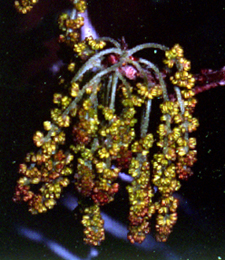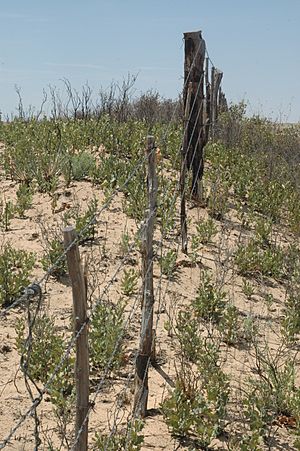Shinnery oak facts for kids
Quick facts for kids Shinnery oak |
|
|---|---|
 |
|
| Conservation status | |
| Scientific classification | |
| Genus: |
Quercus
|
| Species: |
havardii
|
 |
|
| Natural range of Quercus havardii | |
The Shinnery Oak (also called Shin Oak or Havard Oak) is a special type of oak tree. It's usually a short, bushy plant that loses its leaves in the fall. These oaks grow in large groups, covering a huge area in the southern Great Plains of North America.
Even though the parts of the plant you see above ground only live for about 11 to 15 years, the whole plant can be hundreds or even thousands of years old! Shinnery oaks are usually about 1 to 2 meters (3 to 6 feet) tall. They often grow alongside tall grasses, which can sometimes be even taller than the oaks themselves.
The scientific name, Quercus havardii, honors Valery Havard. He was a U.S. Army doctor and botanist who learned a lot about plants in the southwestern United States. The name "shinnery" might come from the French word chêne, which means oak.
Contents
About Shinnery Oak Plants
How Shinnery Oaks Grow
Shinnery oaks are usually short shrubs, but sometimes they can be small trees, growing up to 2 meters (6 feet) tall. They form big groups called "clones" by sending out long underground stems called rhizomes. These rhizomes spread through the sandy soil where the oaks like to live.
Most of the shinnery oak's plant material, about 90% or more, is actually underground! These underground stems can spread out to form plants that are 3 to 15 meters (10 to 50 feet) wide or even larger. Some single clones have been reported to cover an area as big as 81 hectares (200 acres) and live for over 13,000 years!
Flowers and Reproduction
Shinnery oaks have both male and female flowers on the same plant. This is called being monoecious. The male flowers grow in long, hanging clusters called catkins, which are about 1.5 to 3.8 cm (0.6 to 1.5 inches) long. The female flowers are much smaller, only 3 to 7 mm (0.1 to 0.3 inches) long, and usually grow on young shoots.
The wind carries pollen from the male flowers to the female flowers. This happens in the spring.
Acorns and Seeds
After the flowers are pollinated, the acorns start to grow. They take about a year to fully develop and are ready in the autumn. Shinnery oak acorns grow alone or in small groups of 2 or 3. They are about 12 to 25 mm (0.5 to 1 inch) long and 14 to 18 mm (0.5 to 0.7 inches) wide. A scaly cup covers about one-third to one-half of the nut.
Shinnery oaks don't produce a lot of acorns every year. On average, they have a good acorn crop only about 3 out of every 10 years.
Leaves and Twigs
The leaves of the shinnery oak are tough and leathery. They can be grey-green or olive-green and are shiny on top. The underside of the leaves is whitish and covered with tiny hairs. The leaves grow in an alternate pattern along the stem. They are simple (not divided into smaller leaflets) and can be different shapes, like oblong, oval, or elliptical. Their edges can be wavy or have shallow lobes. Each leaf is usually 2 to 8 cm (0.8 to 3 inches) long and 2 to 4 cm (0.8 to 1.5 inches) wide.
The twigs are brown or grayish, about 1 to 2.5 mm (0.04 to 0.1 inches) thick. They might have short hairs when they are young, but these hairs fall off as the twigs get older. The buds are dark reddish-brown and round, about 2 mm (0.08 inches) long.
Bark
The bark on the larger stems of the shinnery oak is light gray and scaly.
Where Shinnery Oaks Live
Shinnery oaks are native to certain parts of the United States. You can find them in western Oklahoma, western Texas, and eastern New Mexico. There are also two small groups of them in southwest Kansas. A different type of shinnery oak can be found in northeastern Arizona and southeastern Utah.
These oaks love sandy areas like sandy plains, sand dunes, and sand hills in the southern Great Plains.
How People Manage Shinnery Oaks
Most shinnery oaks grow on private land. This land is often used for farming or raising animals like cattle. Sometimes, people see shinnery oaks as a problem because they compete with plants that are better for cattle to eat. Also, the buds and leaves of shinnery oaks can make cattle sick for a few weeks in the spring.
Because of these reasons, people have often tried to remove shinnery oaks using chemicals or machines. However, most experts now suggest that it's better not to get rid of all the shinnery oaks. They say that there's usually more food for livestock if some shinnery oaks remain in the area.
Removing too many shinnery oaks can also cause problems. It can leave the sandy soil open to strong winds, which can blow the soil away. It can also harm the homes of many wild animals.
If there's a fire, shinnery oaks grow back very quickly from their underground stems. Researchers say these plants are "extremely fire hardy," meaning they can survive fires very well.
Uses and Importance
Shinnery oaks are very important for their environment. Since they grow well in tough, sandy places, they help to hold the sand dunes in place. This stops the wind from blowing the sandy soil away.
They also provide food and shelter for many different kinds of wildlife.
- Animals like collared peccaries, lesser prairie-chickens, northern bobwhites, and many other species eat shinnery oak acorns.
- Deer, pronghorn, and southern plains woodrats eat the leaves and twigs of shinnery oaks.
- Many other animals use shinnery oak habitats, including black-tailed jackrabbits, desert cottontails, eastern cottontails, wild turkeys, western box turtles, many insects, about 25 types of snakes, and about 10 types of lizards, including the endangered sand dune lizard.
Many animals that people hunt, like Scaled quail and northern bobwhites, use shinnery oak areas a lot. Shinnery oak habitats are also considered the main home for white-tailed deer in the southern Great Plains.
Compared to the surrounding shortgrass plains, shinnery oak areas are rich homes for wildlife. It's important to think carefully about how to manage these areas, as keeping good homes for wildlife and growing food for livestock can sometimes be difficult to balance.
See also
 In Spanish: Quercus havardii para niños
In Spanish: Quercus havardii para niños



